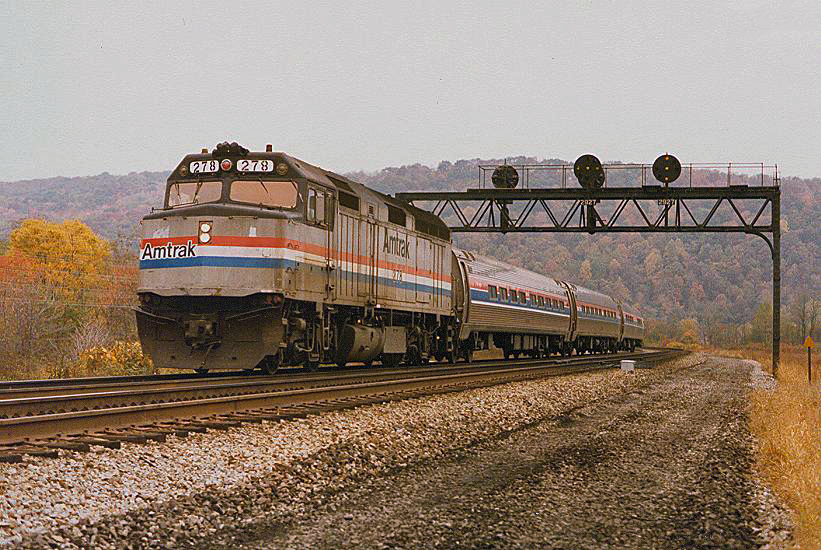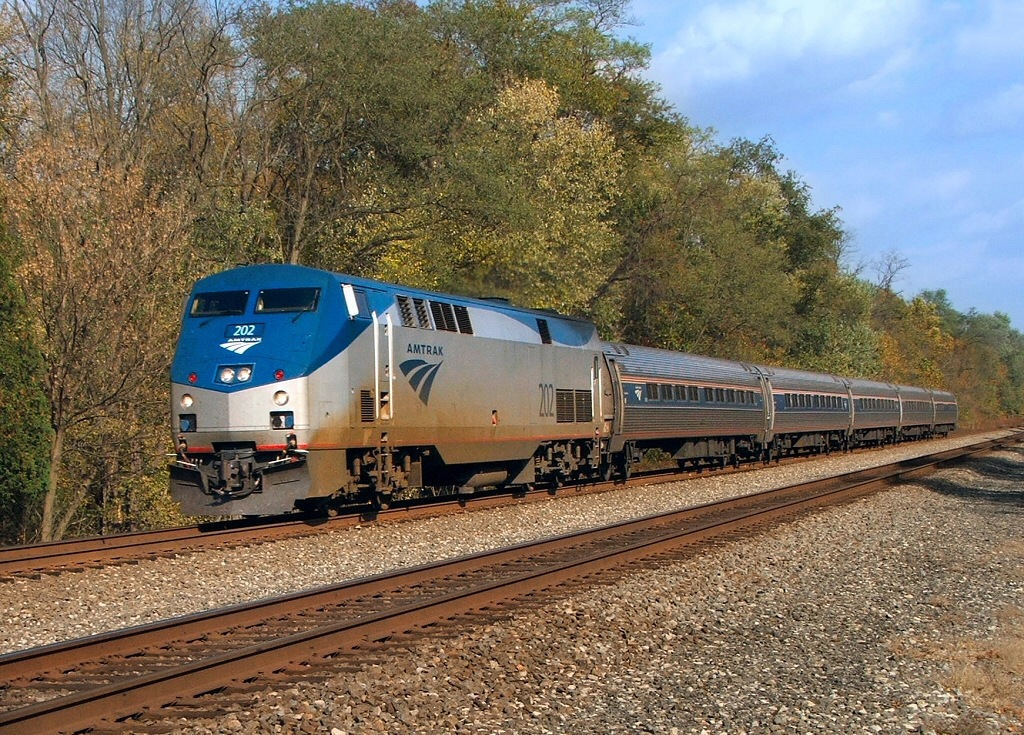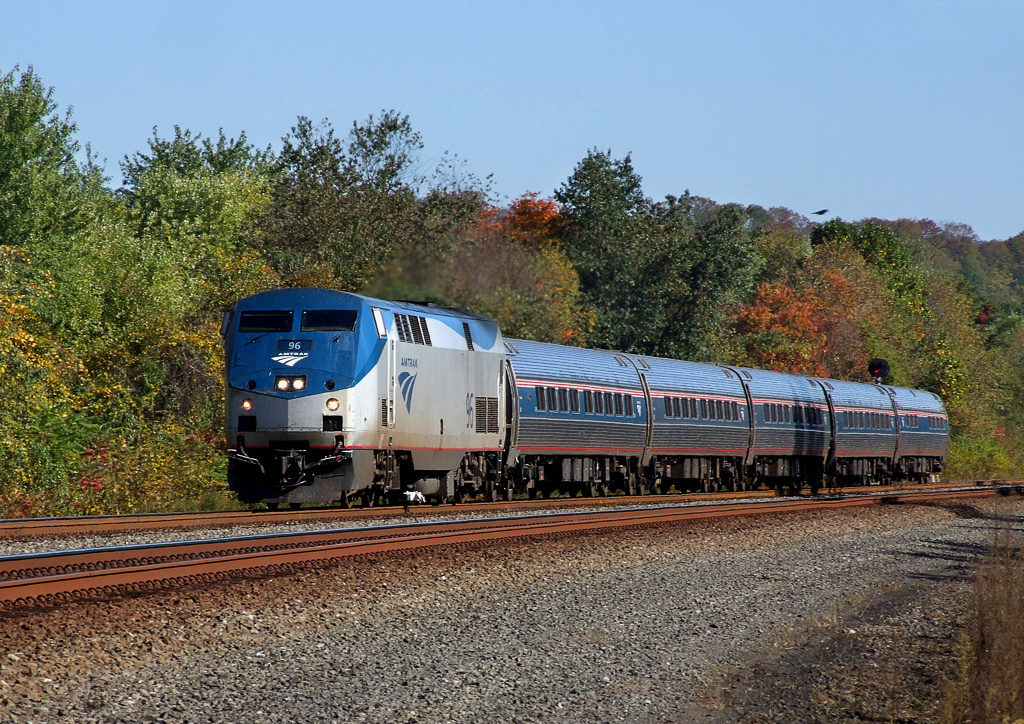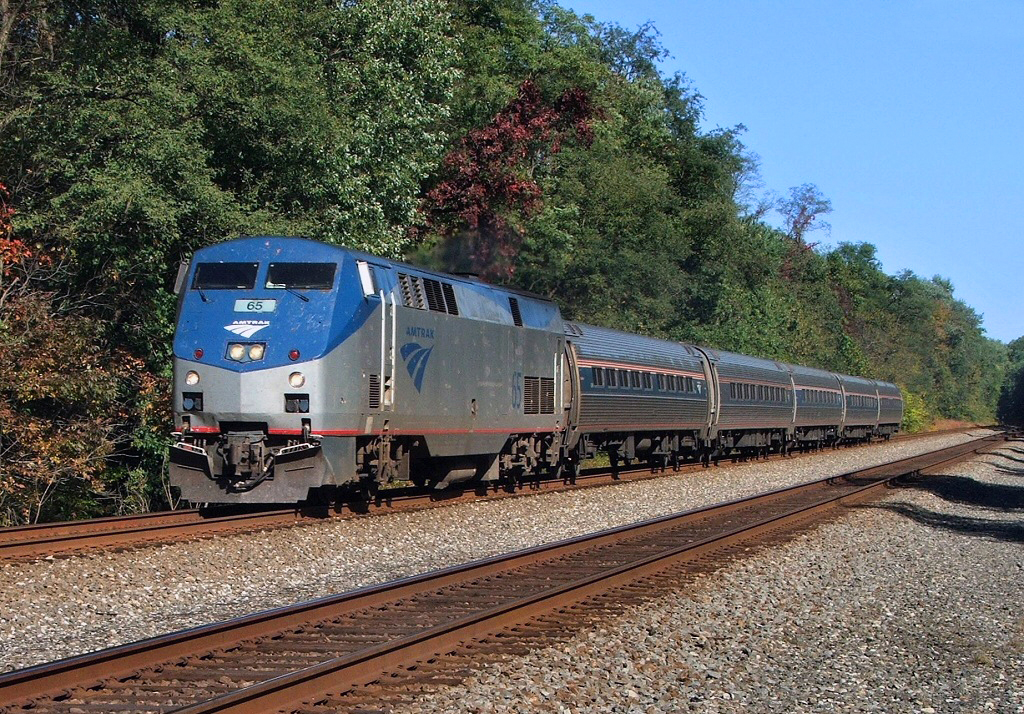- Home ›
- Amtrak ›
- Pennsylvanian
Amtrak's "Pennsylvanian" (Train): Route, Stations, Overview
Last revised: February 25, 2025
By: Adam Burns
The Pennsylvanian is Amtrak's regional service that connects the
Steel City, Pittsburgh, with New York. It is partially subsidized by
the state of Pennsylvania hence the train's name. There are also
several other trains that run this same line through the state although
they connect to different cities.
The currently named route has been running since 1980 although it once was known by two other names; the Keystone and the Duquesne.
The latter train was historic in that in was inaugurated by the fabled Pennsylvania Railroad itself to serve the same corridor as Amtrak's current train.
Today, the train is fairly popular due to the large population centers and region it serves and offers passengers quite a scenic tour of the state's rolling countryside.
The future of the run looks bright despite the fact that there are few amenities provided on board.
 Amtrak's "Pennsylvanian" travels eastbound under the old PRR signal bridge at New Florence, Pennsylvania on October 16, 1984. Doug Kroll photo.
Amtrak's "Pennsylvanian" travels eastbound under the old PRR signal bridge at New Florence, Pennsylvania on October 16, 1984. Doug Kroll photo.The history of the current New York to Pittsburgh corridor can actually be traced long before Amtrak was ever conceived.
With the Pennsylvania Railroad's main lines to both Chicago and St. Louis operating directly through the heart of the Keystone State and splitting at Pittsburgh the company ran numerous named trains between the Steel City, Philadelphia, and New York such as:
- The flagship Broadway Limited
- St. Louisan (New York/Washington - St. Louis)
- Duquesne (New York - Pittsburgh)
- Pittsburgher
The latter two trains, of course, served the Steel City and by the time Penn Central was created in 1968 the only regional Keystone Corridor trains remaining included the Duquesne (originally named after Fort Duquesne in Pittsburgh) and Silverliner Service (Philadelphia - Harrisburg).
During the heyday of these trains the Pennsy offered the very finest of services such as full course meals, lounge cars, reclining seat coaches, and the friendliness staff.
Additionally, trains operated at such high speeds that a run from New York to Pittsburgh required less than eight hours, which is a far cry from today's nearly 10 hours aboard Amtrak.
As the 1960s progressed, however, these services rapidly declined with railroads becoming increasingly disinterested in passenger trains which were dragging down the companies' bottom lines.
The public was simply no longer in love with trains. After the Penn Central merger this decline only accelerated. After Amtrak began operations on May 1, 1971 the Duquesne was retained briefly.
However, with the arrival of the carrier's first official timetable on November 14, 1971 it was renamed as the Keystone, trains #42 and #43.
 Amtrak's "Pennsylvanian" travels westbound through Vandyke, Pennsylvania led by P42DC #202 on October 21, 2006. Rob Kitchen photo.
Amtrak's "Pennsylvanian" travels westbound through Vandyke, Pennsylvania led by P42DC #202 on October 21, 2006. Rob Kitchen photo.Fortunately, the Keystone survived only a year until June 10, 1972 as Amtrak's budget continued to force the company into scaling back its services.
One way it did this was to cancel the New York-Pittsburgh market altogether, leaving only the Broadway Limited and Keystone Service (New York-Harrisburg).
However, thanks to the state funding support from Pennsylvania the route was reborn and on April 27, 1980 and became known as the Pennsylvanian.
Initially, this train connected only Philadelphia and Pittsburgh with connecting service to New York available through the now defunct Philadelphian.
It was a daytime-only train with one trip operated in each direction along the Keystone Corridor with F40PHs usually the preferred power and Amfleet cars for equipment.
 Amtrak P42DC #96 hustles train #41, the westbound "Pennsylvanian," near Bailey, Pennsylvania on October 11, 2008. Rob Kitchen photo.
Amtrak P42DC #96 hustles train #41, the westbound "Pennsylvanian," near Bailey, Pennsylvania on October 11, 2008. Rob Kitchen photo.However, during the 1980s a lot of changes occurred as Pennsylvania tried to decide just how much funding it wished to devote towards passenger rail.
In 1981 the Fort Pitt was operated in tandem with the Pennsylvanian to serve Pittsburgh-Altoona. However, dismal ridership saw this end just two years later in 1983, which was also due to funding cuts by the state.
In 1984 the state again pushed for more service to Pittsburgh but Amtrak was not in financial shape to do so.
In the proceeding years a number of changes came to the train such as extensions to Chicago and Cleveland. However, these were all temporary. After January 27, 2003 it has remained on a routing that serves Pittsburgh and New York.
As of today, the train continues to use dated Amfleet cars for equipment which offer passengers both standard and business class accommodations as well as snack car services.
Power is typically provided by a GE Genesis series diesel locomotive. The current corridor is 444 miles in length and a trip one-way requires nearly 9.5 hours (much longer than the PRR's Duquesne).
Despite few amenities and a slower schedule than during the Golden Age of rail travel the train continues to see healthy ridership with more than 200,000 patrons riding annually.
As Amtrak's notes on its website the scenery is sometimes a forgotten
trademark of this train with views of the Amish "Dutch Country",
Monongahela and Ohio Rivers, Allegheny Mountains, and Pennsy's famous
Horseshoe Curve.
Recent Articles
-
Wisconsin Dinner Train Rides In North Freedom!
Jan 06, 26 10:18 PM
Featured here is a practical guide to Mid-Continent’s dining train concept—what the experience is like, the kinds of menus the museum has offered, and what to expect when you book. -
Pennsylvania Dinner Train Rides In Boyertown!
Jan 06, 26 06:48 PM
With beautifully restored vintage equipment, carefully curated menus, and theatrical storytelling woven into each trip, the Colebrookdale Railroad offers far more than a simple meal on rails. -
North Carolina ~ Murder Mystery ~ Dinner Train Ride
Jan 06, 26 11:26 AM
While there are currently no murder mystery dinner trains in the Tarheel State the Burgaw Depot does host a murder mystery dinner experience in September! -
Florida's - Murder Mystery - Dinner Train Rides
Jan 06, 26 11:23 AM
Florida, known for its vibrant culture, dazzling beaches, and thrilling theme parks, also offers a unique blend of mystery and fine dining aboard its murder mystery dinner trains. -
New Mexico's - Wine Tasting - Train Rides
Jan 06, 26 11:19 AM
For oenophiles and adventure seekers alike, wine tasting train rides in New Mexico provide a unique opportunity to explore the region's vineyards in comfort and style. -
Ohio's - Wine Tasting - Train Rides
Jan 06, 26 11:14 AM
Among the intriguing ways to experience Ohio's splendor is aboard the wine tasting trains that journey through some of Ohio's most picturesque vineyards and wineries. -
Connecticut's Thomas The Train Rides
Jan 06, 26 11:06 AM
For 2026, the tour stop at Essex brings Thomas (and Percy, too) to the historic Valley Railroad for a full day of events for the kids. -
Maryland's Thomas The Train Rides
Jan 06, 26 11:00 AM
In 2026, the B&O Railroad Museum in Baltimore welcomes the Let’s Rock, Let’s Roll Tour with four event days that combine a Thomas-themed excursion with other activities. -
Tennessee's Thomas The Train Rides
Jan 06, 26 10:51 AM
Set on the grounds of one of the Southeast’s best-known operating railroad museums, the Thomas the train event blends kid-friendly fun with the unmistakable sights, sounds, and atmosphere of a real wo… -
Georgia's Thomas The Train Rides
Jan 06, 26 10:44 AM
Day Out With Thomas is set to roll back into Cordele in 2026, bringing Thomas the Tank Engine and a full family festival to the SAM Shortline at Georgia Veterans Memorial State Park. -
Staten Island Rapid Transit
Jan 06, 26 10:02 AM
The Staten Island Rapid Transit has long served Staten Island since the 19th century and today is known as the Staten Island Railway. -
New York Dinner Train Rides In The Adirondacks!
Jan 05, 26 09:45 PM
Operating over a restored segment of the former New York Central’s Adirondack Division, the Adirondack Railroad has steadily rebuilt both track and public interest in passenger rail across the region. -
Ohio Dinner Train Rides On The CVSR!
Jan 05, 26 08:32 PM
While the railroad is well known for daytime sightseeing and seasonal events, one of its most memorable offerings is its evening dining program—an experience that blends vintage passenger-car ambience… -
Pennsylvania's - Wine Tasting - Train Rides
Jan 05, 26 01:08 PM
Wine tasting trains are a unique and enchanting way to explore the state’s burgeoning wine scene while enjoying a leisurely ride through picturesque landscapes. -
West Virginia - Wine Tasting - Train Rides
Jan 05, 26 01:02 PM
West Virginia, often celebrated for its breathtaking landscapes and rich history, offers visitors a unique way to explore its rolling hills and picturesque vineyards: wine tasting trains. -
Virginia - Wine Tasting - Train Rides
Jan 05, 26 12:58 PM
Wine tasting trains in Virginia provide just that—a unique experience that marries the romance of rail travel with the sensory delights of wine exploration. -
Utah - Wine Tasting - Train Rides
Jan 05, 26 12:37 PM
Utah, a state widely celebrated for its breathtaking natural beauty and dramatic landscapes, is also gaining recognition for an unexpected yet delightful experience: wine tasting trains. -
Kentucky Valentine's Train Rides
Jan 05, 26 12:31 PM
If you’re looking for a date night that feels a little more cinematic than the usual reservation-and-a-movie routine, Bardstown’s My Old Kentucky Dinner Train delivers the kind of evening you remember… -
Pennsylvania Valentine's Train Rides
Jan 05, 26 12:12 PM
Tucked amid the rolling farmland of Lancaster County, Pennsylvania, the Strasburg Rail Road stands as one of the most celebrated and successful heritage railroads in North America. -
New York's - Murder Mystery - Dinner Train Rides
Jan 05, 26 11:01 AM
New York State, renowned for its vibrant cities and verdant countryside, offers a plethora of activities for locals and tourists alike, including murder mystery train rides!





















